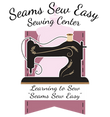|
Have you ever stared at a pattern and felt lost? Or maybe your seams just never seem to lie quite flat? We've all been there! And we've all developed our own list of tips, tricks, and secrets that we swear by. Despite this, there's always new tips and techniques to learn, and with 20+ years of experience under her belt, Stephanie has a wealth of sewing secrets she's dying to share. So grab your fabric, fire up your machine, and get ready to sew like a pro!
|
|
1. Bye-Bye, Bobbin Winding!
Is there anything more annoying than having to stop in the middle of a project, unthread your needle, and wind a new bobbin? Well, I can probably think of a few things, but we'll get to those later. Enter: pre-wounds! You can get bobbins that are pre-wound with 60-wt bobbin thread, and when one runs out, you just pop another one in and keep sewing, with no interruption to your stitching.
You're probably used to a 40 or 50-weight thread in your bobbin, since that's what most threads are, but 60-weight offers the advantage of getting more thread on each bobbin, with only a small adjustment to tension. If your machine has automatic tensions, you won't even notice a difference! If you have manual tensions, you'll only need a slight tension adjustment, if anything at all. If you're willing to pay a little extra for convenience, I highly recommend pre-wound bobbins.
2. A New Kind of Seam Ripper
As much as we hate to admit it sometimes, we all have to rip out seams from our projects. Everyone does it a little differently, but I think we can all agree it takes way too long. But recently, we learned that you can use an unlikely tool as a quick and effective seam ripper.... a dog trimmer!
Ok, it sounds a little strange, but other people have caught on to it too; there's even a few notions companies starting to manufacture them. Sadly, they haven't come to our distributors yet, but we're crossing our fingers we can get our hands on some soon! If you're curious, we have one in the store you can try out- it's seriously magical.
3. No-Hassle Zippers
I think we can all agree that putting zippers in any project is kind of the worst. Depending on which brand of sewing machine you have, zipper feet can range from 'pretty okay' to 'more difficult than the regular presser foot'. If yours is towards the latter end of the spectrum, pick up a piping foot next time you're at your local dealer. Most of the time, the channel in the piping foot fits over the zipper perfectly, and you can get your needle right up next to those teeth without having to fight with it.
4. Sometimes Less Is Better
Raise your hand if you've ever shelled out for those really fancy gadgets? Yeah, me too. I think the biggest culprit is probably those $300 irons- you know the ones. They're so pretty and professional looking, but six months later you're at your wits end because it just doesn't get hot enough, or it's leaking water, or any of those other things we thought the fancy irons would fix.
Next time, get your iron at your local Meijer or Walmart; they'll perform just as well for a fraction of the price. Personally, I've been using a $20 iron from Meijer for about 10 years and never had an issue. Most of the time I'm too lazy to even put water in it, but I still get crisp seams every time. Just another reminder that brand names aren't really any different than generics.
5. On the Subject of Irons
While we're at it, let's talk about our seams. For a long time I was lazy about it and would do seams in batches- for example, putting a whole row of blocks together and then pressing them as a row. But over time, as I've gone on to more complicated patterns and started paying more attention to my points, it became increasingly apparent that I was cheating myself by doing it this way. I would end up with wonky rows, blocks not lining up, etc. So I started a particularly intricate block-of-the-month pattern, and I was so excited I really wanted it to come out perfect. So I pressed every single seam. Not open, mind you, I don't have that much patience, but every seam was pressed before the next one was sewn. And you know what? It really made a difference.

Now, I still get lazy with some projects and go back to my old pressing system, but on the projects I really care about, I have an ironing board butted up against my sewing table (which happens to be the exact same height, which is really nice) so all I have to do after I sew a seam is swivel and press, then swivel back and continue. The little bit of extra time it takes is completely worth it, in my opinion.
Do you have any tips or tricks you'd like to share? Put them in the comments and we might feature them in a future blog!






















